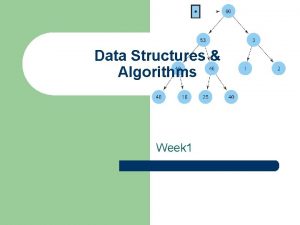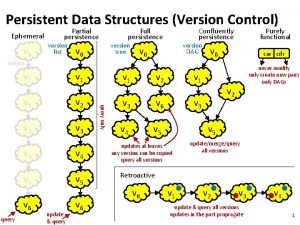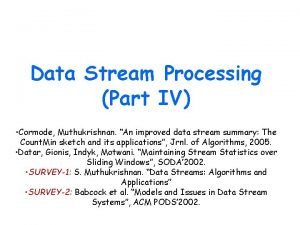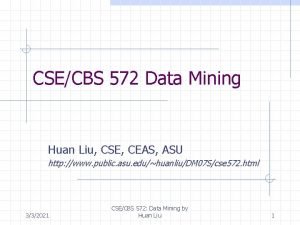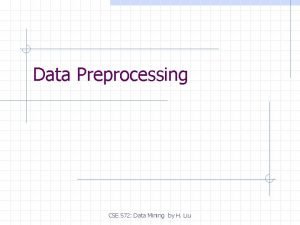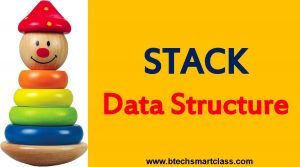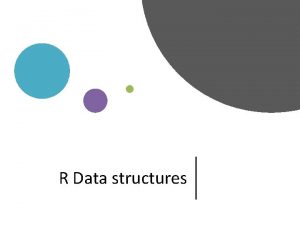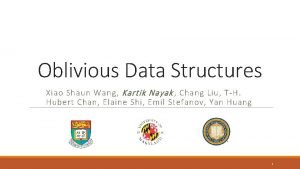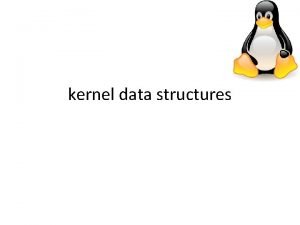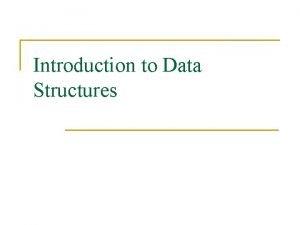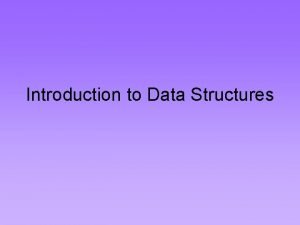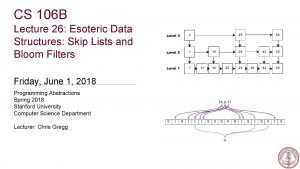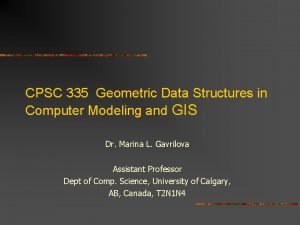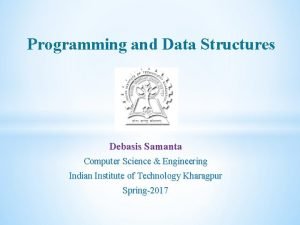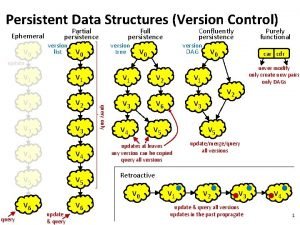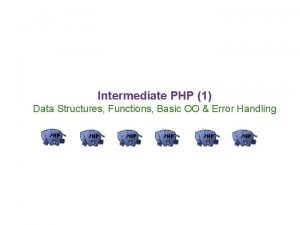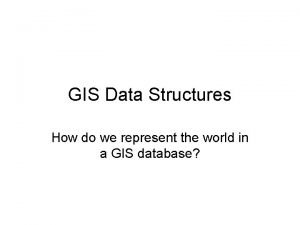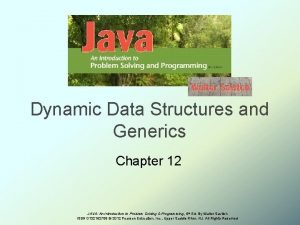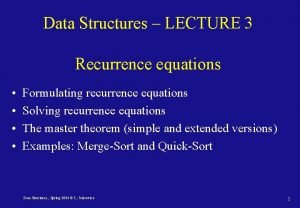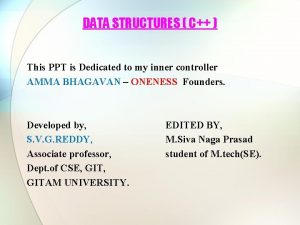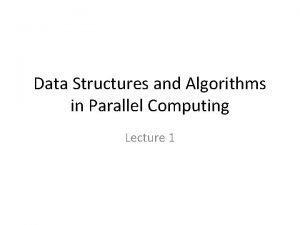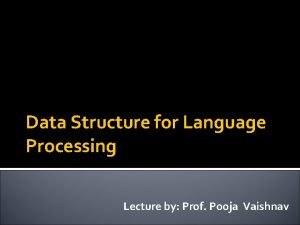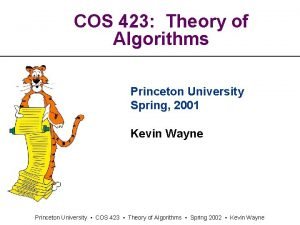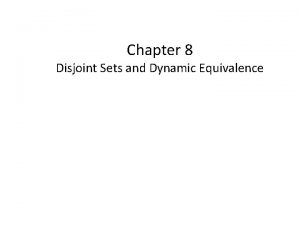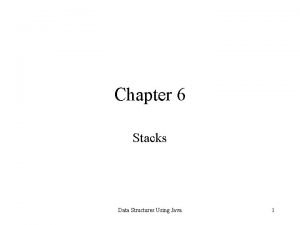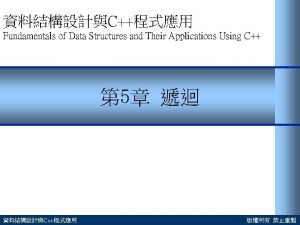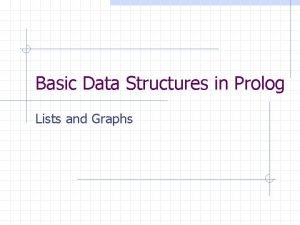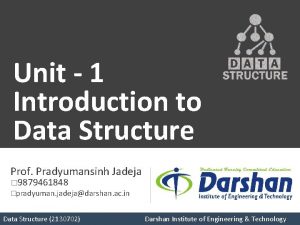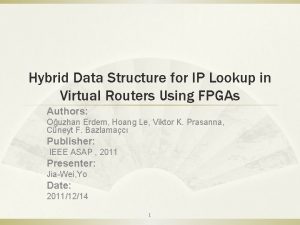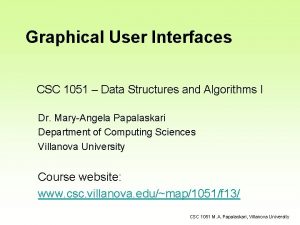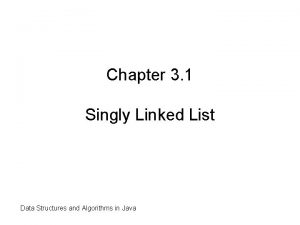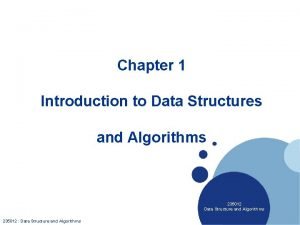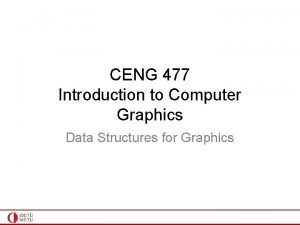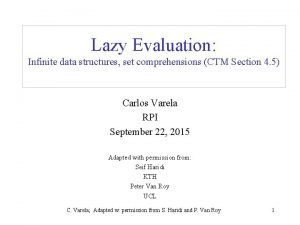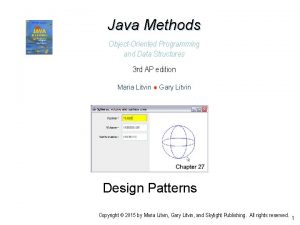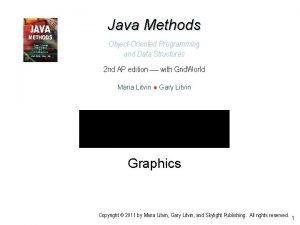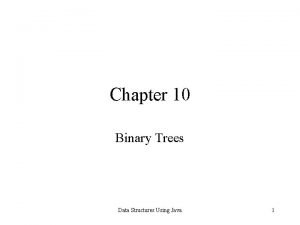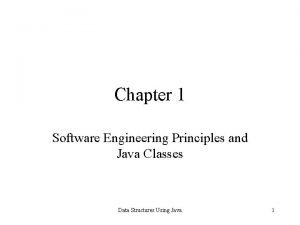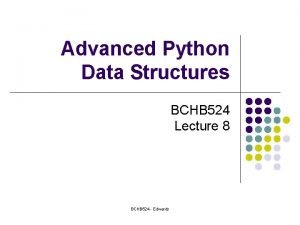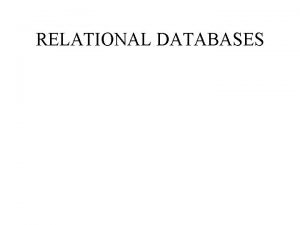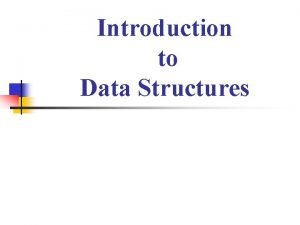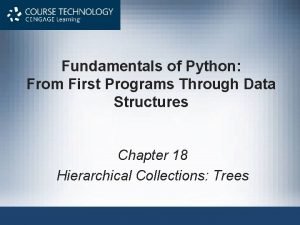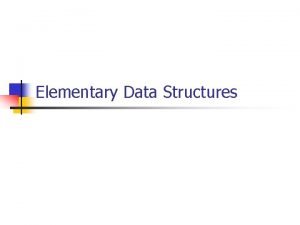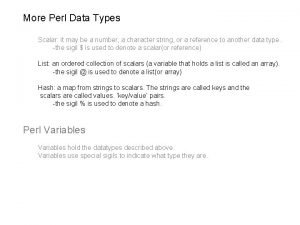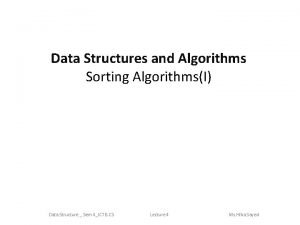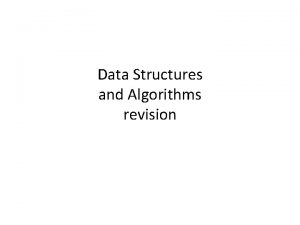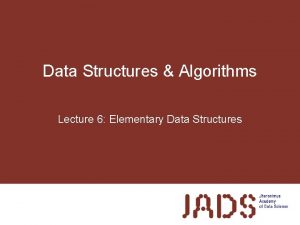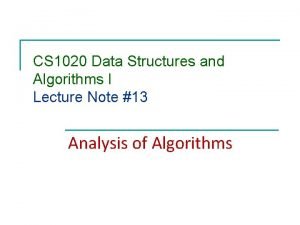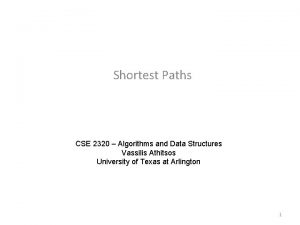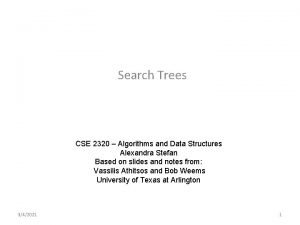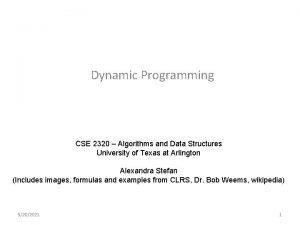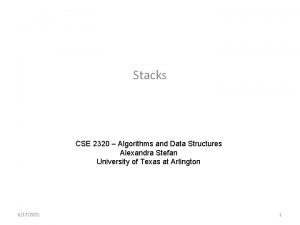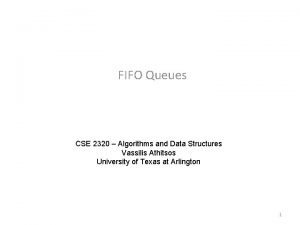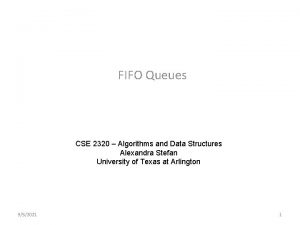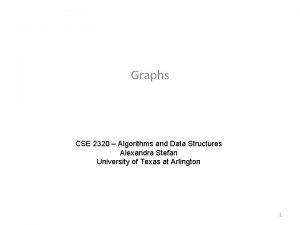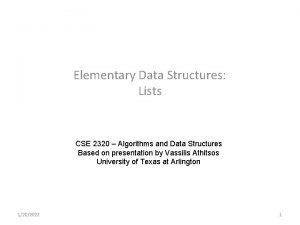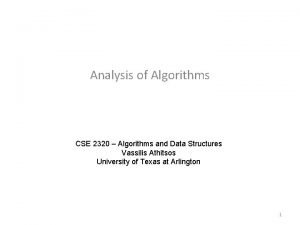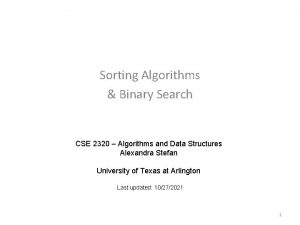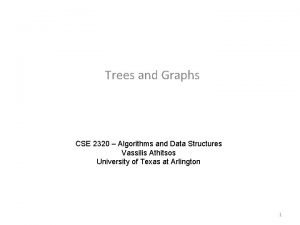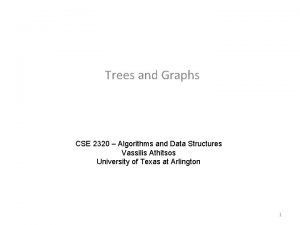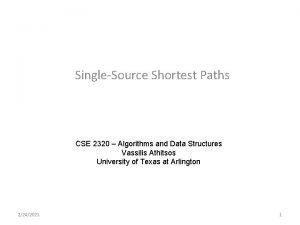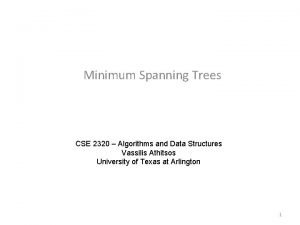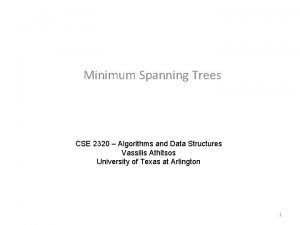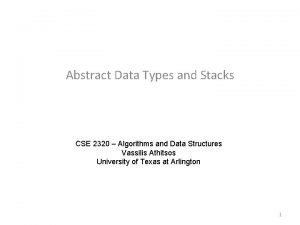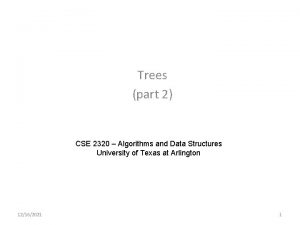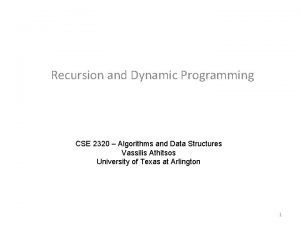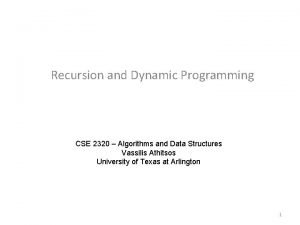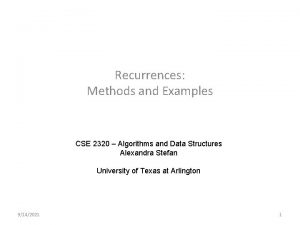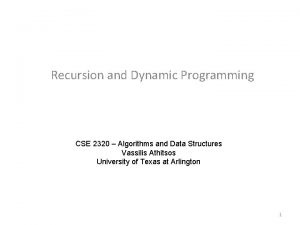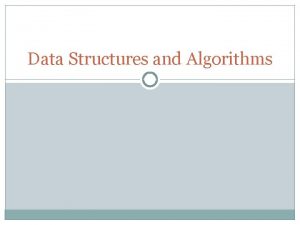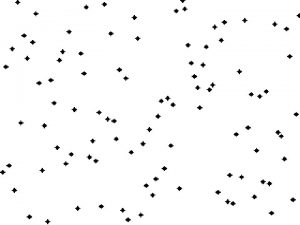Example Algorithms CSE 2320 Algorithms and Data Structures
































![Next Version • id[p] will not point to the set_id of p. – It Next Version • id[p] will not point to the set_id of p. – It](https://slidetodoc.com/presentation_image_h/a444bef0372904b9d2090a964f9118d0/image-33.jpg)
![Second Version int find(int object, int id[]) { int next_object; next_object = id[object]; while Second Version int find(int object, int id[]) { int next_object; next_object = id[object]; while](https://slidetodoc.com/presentation_image_h/a444bef0372904b9d2090a964f9118d0/image-34.jpg)













![Third Version main() { int p, q, i, id[N], sz[n], p_id, q_id; for (i Third Version main() { int p, q, i, id[N], sz[n], p_id, q_id; for (i](https://slidetodoc.com/presentation_image_h/a444bef0372904b9d2090a964f9118d0/image-48.jpg)























- Slides: 71

Example Algorithms CSE 2320 – Algorithms and Data Structures Vassilis Athitsos University of Texas at Arlington 1

Examples of Algorithms • • Union-Find. Binary Search. Selection Sort. What each of these algorithms does is the next topic we will cover. 2

Connectivity: An Example • Suppose that we have a large number of computers, with no connectivity. – No computer is connected to any other computer. • We start establishing direct computer-tocomputer links. • We define connectivity(A, B) as follows: – If A and B are directly linked, they are connected. – If A and B are connected, and B and C are connected, then A and C are connected. • Connectivity is transitive. 3

The Union-Find Problem • We want a program that behaves as follows: – Each computer is represented as a number. – We start our program. – Every time we establish a link between two computers, we tell our program about that link. • How do we tell the computer? What do we need to provide? 4

The Union-Find Problem • We want a program that behaves as follows: – Each computer is represented as a number. – We start our program. – Every time we establish a link between two computers, we tell our program about that link. • How do we tell the computer? What do we need to provide? • Answer: we need to provide two integers, specifying the two computers that are getting linked. 5

The Union-Find Problem • We want a program that behaves as follows: – Each computer is represented as a number. – We start our program. – Every time we establish a link between two computers, we tell our program about that link. – We want the program to tell us if the new link has changed connectivity or not. • What does it mean that "connectivity changed"? 6

The Union-Find Problem • We want a program that behaves as follows: – Each computer is represented as a number. – We start our program. – Every time we establish a link between two computers, we tell our program about that link. – We want the program to tell us if the new link has changed connectivity or not. • What does it mean that "connectivity changed"? • It means that there exist at least two computers X and Y that were not connected before the new link was in place, but are connected now. 7

The Union-Find Problem • We want a program that behaves as follows: – Each computer is represented as a number. – We start our program. – Every time we establish a link between two computers, we tell our program about that link. – We want the program to tell us if the new link has changed connectivity or not. • Can you come up with an example where the new link does not change connectivity? 8

The Union-Find Problem • We want a program that behaves as follows: – Each computer is represented as a number. – We start our program. – Every time we establish a link between two computers, we tell our program about that link. – We want the program to tell us if the new link has changed connectivity or not. • Can you come up with an example where the new link does not change connectivity? • Suppose we have computers 1, 2, 3, 4. Suppose 1 and 2 are connected, and 2 and 3 are connected. Then, 9 directly linking 1 to 3 does not add connectivity.

The Union-Find Problem • We want a program that behaves as follows: – Each computer is represented as a number. – We start our program. – Every time we establish a link between two computers, we tell our program about that link. – We want the program to tell us if the new link has changed connectivity or not. – How do we do that? 10

A Useful Connectivity Property • Suppose we have N computers. • At each point (as we establish links), these N computers will be divided into separate networks. – All computers within a network are connected. – If computers A and B belong to different networks, they are not connected. • Each of these networks is called a connected component. 11

Initial Connectivity • Suppose we have N computers. • Before we have established any links, how many connected components do we have? 12

Initial Connectivity • Suppose we have N computers. • Before we have established any links, how many connected components do we have? – N components: each computer is its own connected component. 13

Labeling Connected Components • Suppose we have N computers. • Suppose we have already established some links, and we have K connected components. • How can we keep track, for each computer, what connected component it belongs to? 14

Labeling Connected Components • Suppose we have N computers. • Suppose we have already established some links, and we have K connected components. • How can we keep track, for each computer, what connected component it belongs to? – Answer: maintain an array id of N integers. – id[p] will be the ID of the connected component of computer p (where p is an integer). – For convenience, we can establish the convention that the ID of a connected component X is just some integer p such that computer p belongs to X. 15

The Union-Find Problem • We want a program that behaves as follows: – Each computer is represented as a number. – We start our program. – Every time we establish a link between two computers, we tell our program about that link. – We want the program to tell us if the new link has changed connectivity or not. – How do we do that? 16

Union-Find: First Solution • It is rather straightforward to come up with a brute force method: • Every time we establish a link between p and q: – The new link means p and q are connected. – If they were already connected, we do not need to do anything. – How can we check if they were already connected? 17

Union-Find: First Solution • It is rather straightforward to come up with a brute force method: • Every time we establish a link between p and q: – The new link means p and q are connected. – If they were already connected, we do not need to do anything. – How can we check if they were already connected? • Answer: id[p] == id[q] 18

Union-Find: First Solution • It is rather straightforward to come up with a brute force method: • Every time we establish a link between p and q: – The new link means p and q are connected. – If they were not already connected, then the connected components of p and q need to be merged. 19

Union-Find: First Solution • It is rather straightforward to come up with a brute force method: • Every time we establish a link between p and q: – The new link means p and q are connected. – If they were not already connected, then the connected components of p and q need to be merged. – We can go through each computer i in the network, and if id[i] == id[p], we set id[i] = id[q]. 20

Union-Find: First Solution #include <stdio. h> #define N 10000 main() { int i, p, q, t, id[N]; for (i = 0; i < N; i++) id[i] = i; while (scanf("%d %dn", &p, &q) == 2) { if (id[p] == id[q]) continue; for (t = id[p], i = 0; i < N; i++) if (id[i] == t) id[i] = id[q]; printf(" %d %dn", p, q); } } 21

Time Analysis • The first solution to the Union-Find problem takes at least M*N instructions, where: – N is the number of objects. – M is the number of union operations. • What is the best case, that will lead to faster execution? 22

Time Analysis • The first solution to the Union-Find problem takes at least M*N instructions, where: – N is the number of objects. – M is the number of union operations. • What is the best case, that will lead to faster execution? – Best case: all links are identical, we only need to do one union. Then, we need at least N instructions. 23

Time Analysis • The first solution to the Union-Find problem takes at least M*N instructions, where: – N is the number of objects. – M is the number of union operations. • What is the worst case, that will lead to the slowest execution? 24

Time Analysis • The first solution to the Union-Find problem takes at least M*N instructions, where: – N is the number of objects. – M is the number of union operations. • What is the worst case, that will lead to the slowest execution? – Worst case: each link requires a new union operation. Then, we need at least N*L instructions, where L is the number of links. 25

Time Analysis • The first solution to the Union-Find problem takes at least M*N instructions, where: – N is the number of objects. – M is the number of union operations. – L is the number of links. • Source of variance: M. In the best case, M = ? ? ? . In the worst case, M = ? ? ? . 26

Time Analysis • The first solution to the Union-Find problem takes at least M*N instructions, where: – N is the number of objects. – M is the number of union operations. – L is the number of links. • Source of variance: M. In the best case, M = 1. In the worst case, M = L. 27

The Find and Union Operations • find: given an object p, find out what set it belongs to. • union: given two objects p and q, unite their two sets. • Time complexity of find in our first solution: – ? ? ? • Time complexity of union in our first solution: – ? ? ? 28

The Find and Union Operations • find: given an object p, find out what set it belongs to. • union: given two objects p and q, unite their two sets. • Time complexity of find in our first solution: – Just checking id[p]. – One instruction in C, a constant number of instructions on the CPU. • Time complexity of union in our first solution: – At least N instructions, if p and q belong to different sets. 29

Rewriting First Solution With Functions - Part 1 #include <stdio. h> #define N 10 /* Made N smaller, so we can print all ids */ /* returns the set id of the object. */ int find(int object, int id[]) { return id[object]; } /* unites the two sets specified by set_id 1 and set_id 2*/ void set_union(int set_id 1, int set_id 2, int id[], int size) { int i; for (i = 0; i < size; i++) if (id[i] == set_id 1) id[i] = set_id 2; } 30

Rewriting First Solution With Functions - Part 2 main() { int p, q, i, id[N], p_id, q_id; for (i = 0; i < N; i++) id[i] = i; while (scanf("%d %d", &p, &q) == 2) { p_id = find(p, id); q_id = find(q, id); if (p_id == q_id) { printf(" %d and %d were on the same setn", p, q); continue; } set_union(p_id, q_id, N); printf(" %d %d link led to set unionn", p, q); for (i = 0; i < N; i++) printf(" id[%d] = %dn", i, id[i]); } } } 31

Why Rewrite? • The rewritten code makes the find and union operations explicit. • We can replace find and union as we wish, and we can keep the main function unchanged. • Note: union is called set_union in the code, because union is a reserved keywords in C. • Next: try different versions of find and union, to make the code more efficient. 32
![Next Version idp will not point to the setid of p It Next Version • id[p] will not point to the set_id of p. – It](https://slidetodoc.com/presentation_image_h/a444bef0372904b9d2090a964f9118d0/image-33.jpg)
Next Version • id[p] will not point to the set_id of p. – It will point to just another element of the same set. – Thus, id[p] initiates a sequence of elements: – id[p] = p 2, id[p 2] = p 3, …, id[pn] = pn • This sequence of elements ends when we find an element pn such that id[pn] = pn. • We will call this pn the id of the set. • This sequence is not allowed to contain cycles. • We re-implement find and union to follow these rules. 33
![Second Version int findint object int id int nextobject nextobject idobject while Second Version int find(int object, int id[]) { int next_object; next_object = id[object]; while](https://slidetodoc.com/presentation_image_h/a444bef0372904b9d2090a964f9118d0/image-34.jpg)
Second Version int find(int object, int id[]) { int next_object; next_object = id[object]; while (next_object != id[next_object]) next_object = id[next_object]; return next_object; } /* unites the two sets specified by set_id 1 and set_id 2 */ void set_union(int set_id 1, int set_id 2, int id[], int size) { id[set_id 1] = set_id 2; } 34

id Array Defines Trees of Pointers • By drawing out what points to what in the id array, we obtain trees. – Each connected component corresponds to a tree. – Each object p corresponds to a node whose parent is id[p]. – Exception: if id[p] == p, then p is the root of a tree. • In first version of Union-Find, a connected component of two or more objects corresponded to a tree with two levels. • Now, a connected component of n objects (n >= 2) can have anywhere from 2 to n levels. • See textbook figures 1. 4, 1. 5 (pages 13 -14). 35

Time Analysis of Second Version • How much time does union take? • How much time does find take? 36

Time Analysis of Second Version • How much time does union take? – a constant number of operations (which is the best result we could hope for). • How much time does find take? – find(p) needs to find the root of the tree that p belongs to. This needs at least as many instructions as the distance from p to the root of the tree. 37

Time Analysis of Second Version • Worst case? 38

Time Analysis of Second Version • Worst case: we process M links in this order: – – – 10 21 32 … M M-1 • Then, how will the ids look after we process each link? 39

Time Analysis of Second Version • Worst case: we process M links in this order: – – – 10 21 32 … M M-1 • Then, how will the ids look after we process the m-th link? – id[m] = m-1, id[m-1] = m-2, id[m-2] = m-3, … 40

Time Analysis of Second Version • Worst case: we process links in this order: – 1 0, 2 1, 3 2, …, M M-1. • Then, how will the ids look after we process each link? – id[m] = m-1, id[m-1] = m-2, id[m-2] = m-3, … • How many instructions will find take? 41

Time Analysis of Second Version • Worst case: we process links in this order: – 1 0, 2 1, 3 2, …, M M-1. • Then, how will the ids look after we process each link? – id[m] = m-1, id[m-1] = m-2, id[m-2] = m-3, … • How many instructions will find take? – at least m instructions for the m-th link. • Total? 42

Time Analysis of Second Version • Worst case: we process links in this order: – 1 0, 2 1, 3 2, …, M M-1. • Then, how will the ids look after we process each link? – id[m] = m-1, id[m-1] = m-2, id[m-2] = m-3, … • How many instructions will find take? – at least m instructions for the m-th link. • Total? 1 + 2 + 3 + … + M = 0. 5 * M * (M+1). So, at least 0. 5 * M 2 instructions. Quadratic in M. • Compare to first version: M*N. Which is better? 43

Time Analysis of Second Version • Worst case: we process links in this order: – 1 0, 2 1, 3 2, …, M M-1. • Then, how will the ids look after we process each link? – id[m] = m-1, id[m-1] = m-2, id[m-2] = m-3, … • How many instructions will find take? – at least m instructions for the m-th link. • Total? 1 + 2 + 3 + … + M = 0. 5 * M * (M+1). So, at least 0. 5 * M 2 instructions. Quadratic in M. • Compare to first version: M*N. Which is better? – The new version, if M < N. 44

Time Analysis of Second Version • Worst case: we process links in this order: – 1 0, 2 1, 3 2, …, M M-1. • Then, how will the ids look after we process each link? – id[m] = m-1, id[m-1] = m-2, id[m-2] = m-3, … • What if M > N? • Then the number of instructions is: 1+2+3+…+N+N+…+N. • Still better than first version (where we need M*N instructions). Compare: 1+2+3+…+N+N+…+N (second version) N+N+N+…+N (first version) 45

Second Vs. First Version • The second version is faster, but not by much. – About two times faster. – A constant factor of two will not be considered a big deal in this class. – Preview of chapter 2: constant factors like this will mostly be ignored. 46

Third Version • find: same as in second version. • union: always change the id of the smaller set to that of the larger one. void set_union(int set_id 1, int set_id 2, int id[], int sz[]) { if (sz[set_id 1] < sz[set_id 2]) { id[set_id 1] = set_id 2; sz[set_id 2] += sz[set_id 1]; } else { id[set_id 2] = set_id 1; sz[set_id 1] += sz[set_id 2]; } 47 }
![Third Version main int p q i idN szn pid qid for i Third Version main() { int p, q, i, id[N], sz[n], p_id, q_id; for (i](https://slidetodoc.com/presentation_image_h/a444bef0372904b9d2090a964f9118d0/image-48.jpg)
Third Version main() { int p, q, i, id[N], sz[n], p_id, q_id; for (i = 0; i < N; i++) { id[i] = i; sz[i] = 1; } while (scanf("%d %d", &p, &q) == 2) { p_id = find(p, id); q_id = find(q, id); if (p_id == q_id) { printf(" %d and %d were on the same setn", p, q); continue; } set_union(p_id, q_id, sz); printf(" %d %d link led to set unionn", p, q); for (i = 0; i < N; i++) { printf(" id[%d] = %dn", i, id[i]); } } } 48

Time Analysis of Third Version • What is the key effect of considering the size of the two sets? 49

Time Analysis of Third Version • What is the key effect of considering the size of the two sets? • We get flatter trees. When we merge two trees, we avoid creating long chains. • How does that improve running time? 50

Time Analysis of Third Version • What is the key effect of considering the size of the two sets? • We get flatter trees. When we merge two trees, we avoid creating long chains. • How does that improve running time? • For a connected component of n objects, find will need at most log n operations. – Remember, log is always base 2. • Thus, now we need how many steps in total, for all the find operations in the program? 51

Time Analysis of Third Version • What is the key effect of considering the size of the two sets? • We get flatter trees. When we merge two trees, we avoid creating long chains. • How does that improve running time? • For a connected component of n objects, find will need at most log n operations. – Remember, log is always base 2. • Thus, now we need at most M * log N steps in total. 52

Optional: Fourth Version • As we go through a tree during a find operation, flatten the tree at the same time. int find(int object, int id[]) { int next_object; next_object = id[object]; while (next_object != id[next_object]) { id[next_object] = id[id[next_object]]; next_object = id[next_object]; } return next_object; } 53

Optional: Fourth Version • After repeated find operations, trees get flatter and flatter, and closer to the best case (two levels). int find(int object, int id[]) { int next_object; next_object = id[object]; while (next_object != id[next_object]) { id[next_object] = id[id[next_object]]; next_object = id[next_object]; } return next_object; } 54

Optional: Fourth Version • When all trees are flat (2 levels), how many operations does a single find take? 55

Optional: Fourth Version • When all trees are flat (2 levels), how many operations does a single find take? • It just needs to check id[p]. The number of operations does not depend on the size of the connected component, or the total number of objects. • When the number of operations does not depend on any variables, we say that the number of operations is constant. • A constant number of operations is algorithmically the best case we can ever hope for. 56

Next Problem: Membership Search • We have a set S of N objects. • Given an object v, we want to determine if v is an element of S. • For simplicity, now we will only handle the case where objects are integers. – It will become apparent later in the course that the solution actually works for much more general types of objects. • Can anyone think of a simple solution for this problem? 57

Sequential Search • We have a set S of N objects. • Given an object v, we want to determine if v is an element of S. • Sequential search: – Compare v with every element of S. • How long does this take? 58

Sequential Search • We have a set S of N objects. • Given an object v, we want to determine if v is an element of S. • Sequential search: – Compare v with every element of S. • How long does this take? – If v is in S, we need on average to compare v with |S|/2 objects. – If v is not in S, we need compare v with all |S| objects. 59

Sequential Search - Version 2 • Assume that S is sorted in ascending order (this is an assumption that we did not make before). • Sequential search, version 2: – Compare v with every element of S, till we find the first element s such that s >= v. – Then, if s != v we can safely say that v is not in S. • How long does this take? 60

Sequential Search - Version 2 • Assume that S is sorted in ascending order (this is an assumption that we did not make before). • Sequential search, version 2: – Compare v with every element of S, till we find the first element s such that s >= v. – Then, if s != v we can safely say that v is not in S. • How long does this take? – We need on average to compare v with |S|/2 objects, regardless of whether v is in S or not. • A little bit better than when S was not sorted, but only by a factor of 2, only when v is not in S. 61

Binary Search • Again, assume that S is sorted in ascending order. • At first, if v is in S, v can appear in any position, from 0 to N-1 (where N is the size of S). • Let's call left the leftmost position where v may be, and right the rightmost position where v may be. • Initially: – left = 0 – right = N - 1 • Now, suppose we compare v with S[N/2]. – Note: if N/2 is not an integer, round it down. – What can we say about left and right? 62

Binary Search • Initially: – left = 0 – right = N - 1 • Now, suppose we compare v with S[N/2]. – What can we say about left and right? • • If v == S[N/2], we found v, so we are done. If v < S[N/2], then right = N/2 - 1. If v > S[N/2], then left = N/2 + 1. Importance: We have reduced our search range in half, with a single comparison. 63

Binary Search - Code /* Determines if v is an element of S. If yes, it returns the position of v in a. If not, it returns -1. N is the size of S. */ int search(int S[], int N, int v) { int left, right; left = 0; right = N-1; while (right >= left) { int m = (left+right)/2; if (v == S[m]) return m; if (v < S[m]) right = m-1; else left = m+1; } return -1; } 64

Time Analysis of Binary Search • How many elements do we need to compare v with, if S contains N objects? • At most log(N). • This is what we call logarithmic time complexity. • While constant time is the best we can hope, we are usually very happy with logarithmic time. 65

Next Problem - Sorting • Suppose that we have an array of items (numbers, strings, etc. ), that we want to sort. • Why would we want to sort? 66

Next Problem - Sorting • Suppose that we have an array of items (numbers, strings, etc. ), that we want to sort. • Why would we want to sort? – To use in binary search. – To compute rankings, statistics (top-10, top-100, median). • Sorting is one of the most common operations in software. • In this course we will do several different sorting algorithms, with different properties. • Today we will look at one of the simplest: Selection Sort. 67

Selection Sort • First step: find the smallest element, and exchange it with element at position 0. • Second step: find the second smallest element, and exchange it with element at position 1. • n-th step: find the n-th smallest element, and exchange it with element at position n-1. • If we do this |S| times, then S will be sorted. 68

Selection Sort - Code • For simplicity, we only handle the case where the items are integers. /* sort array S in ascending order. N is the number of elements in S. */ void selection(int S[], int N) { int i, j, temp; for (i = 0; i < N; i++) { int min = i; for (j = i+1; j < N; j++) if (S[j] < S[min]) min = j; temp = S[min]; S[min] = S[i]; S[i] = temp; } } 69

Selection Sort - Time Analysis • First step: find the smallest element, and exchange it with element at position 0. – We need N-1 comparisons. • Second step: find the second smallest element, and exchange it with element at position 1. – We need N-2 comparisons. • n-th step: find the n-th smallest element, and exchange it with element at position n-1. – We need N-n comparisons. • Total: (N-1) + (N-2) + (N-3) + … + 1 = about 0. 5 * N 2 comparisons. 70

Selection Sort - Time Analysis • Total: (N-1) + (N-2) + (N-3) + … + 1 = about 0. 5 * N 2 comparisons. • Quadratic time complexity. • Commonly used sorting algorithms are a bit more complicated, but have N * log(N) time complexity, which is much better (as N gets large). 71
 Used kla-tencor flx-2320
Used kla-tencor flx-2320 Ajit diwan
Ajit diwan Amit agarwal princeton
Amit agarwal princeton Data structures and algorithms tutorial
Data structures and algorithms tutorial Information retrieval data structures and algorithms
Information retrieval data structures and algorithms Data structures and algorithms bits pilani
Data structures and algorithms bits pilani Data structures and algorithms iit bombay
Data structures and algorithms iit bombay Data structures and algorithms
Data structures and algorithms Data structures and algorithms
Data structures and algorithms Ian munro waterloo
Ian munro waterloo Signature file structure in information retrieval system
Signature file structure in information retrieval system Data structures and algorithms
Data structures and algorithms Algorithms + data structures = programs
Algorithms + data structures = programs Human arm and whale flipper function
Human arm and whale flipper function Explain single pass macro processor
Explain single pass macro processor Assembler algorithm and data structures
Assembler algorithm and data structures Data structures and abstractions with java
Data structures and abstractions with java Adts, data structures, and problem solving with c++
Adts, data structures, and problem solving with c++ Data structures and algorithm
Data structures and algorithm Persistent and ephemeral data structures
Persistent and ephemeral data structures Stream data model
Stream data model Cse 572 data mining
Cse 572 data mining Cse 572 data mining
Cse 572 data mining Www.btechsmartclass.com
Www.btechsmartclass.com Types of data structures in r
Types of data structures in r Oblivious data structures
Oblivious data structures Linux kernel data structures
Linux kernel data structures Introduction to data structures
Introduction to data structures Introduction to data structures
Introduction to data structures Esoteric data structures
Esoteric data structures Geometric data structures
Geometric data structures Performing file i/o using hdfs
Performing file i/o using hdfs Advanced data structures in java
Advanced data structures in java Classic data structures by debasis samanta ppt
Classic data structures by debasis samanta ppt Persistent vs ephemeral data structures
Persistent vs ephemeral data structures Php data structures
Php data structures What is data structure in gis
What is data structure in gis Dynamic data structure in java
Dynamic data structure in java Recurrence data structures
Recurrence data structures Data structures in c ppt
Data structures in c ppt Data structures for parallel computing
Data structures for parallel computing Data structures for language processing
Data structures for language processing Cos 423
Cos 423 Smart union algorithm in data structure
Smart union algorithm in data structure Data structures using java
Data structures using java Fundamentals of data structures in c
Fundamentals of data structures in c Prolog graph
Prolog graph Data structure classification
Data structure classification Polynomial adt using linked list
Polynomial adt using linked list Dynamic data structures
Dynamic data structures Hybrid data structures
Hybrid data structures Graphical user interface in data structures
Graphical user interface in data structures Java data structures
Java data structures Data structures chapter 1
Data structures chapter 1 Graphics data structures
Graphics data structures Lazy evaluation
Lazy evaluation Data structures in java
Data structures in java Data structures in java
Data structures in java Binary search tree java
Binary search tree java Data structures using java
Data structures using java Advanced data structures in python
Advanced data structures in python Relational data structures
Relational data structures Data structures
Data structures Fundamentals of python data structures
Fundamentals of python data structures Elementary data structures
Elementary data structures Perl data types
Perl data types Static data structure and dynamic data structure
Static data structure and dynamic data structure Data structures
Data structures Data structures revision
Data structures revision Elementary data structures
Elementary data structures Nf1n
Nf1n Vestigial structures example
Vestigial structures example


















